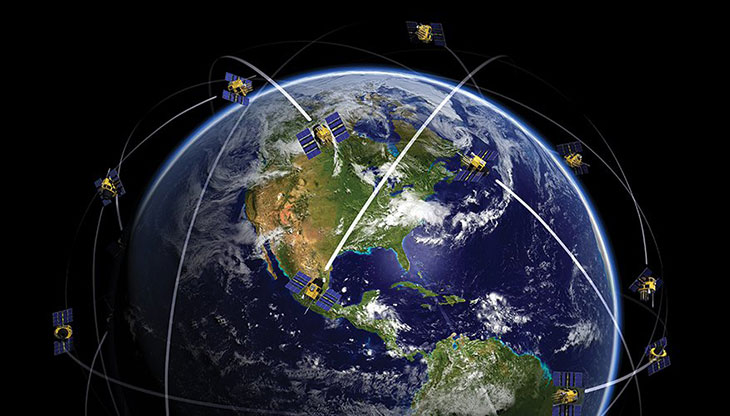ALEXANDRIA, Va. — The need to match the emerging capabilities of non-geostationary orbit (NGSO) constellations has been a driving force and source of inspiration for ground and user segment providers. This is particularly true for antenna and ground terminal manufacturers, who are seeking to leverage the potential of full connectivity across network operators, frequencies, orbits and more.
New LEO and MEO constellations are expanding the list of possible end users for satcom solutions at a time when the appetite for broadband is only growing. The trend has been clear for some time and organizations are addressing demand with more flexible ground systems that can adapt to the complexity of the space layer.
“The industry was ripe for a disruptor,” said Brian Billman, Chief Marketing Officer at ALL.SPACE. “We’ve really seen a renaissance in the space segment with HTS and very high throughput satellites, where they’re maximizing advancements in discreet technology, onboard processing and frequency reuse. We designed our terminal to flourish in those advanced networks.”
 This image shows ALL.SPACE’s S2000, a modular, software-defined terminal that provides access to multiple satellite and terrestrial networks concurrently from a single device. (Source: ALL.SPACE)
This image shows ALL.SPACE’s S2000, a modular, software-defined terminal that provides access to multiple satellite and terrestrial networks concurrently from a single device. (Source: ALL.SPACE)
Earlier this year, the UK-based ALL.SPACE accomplished a goal that has long been desired within the space industry: simultaneously connecting two satellites in different orbits with no performance loss using a single multi-link platform. The initial test was conducted for the U.S. Army and successfully established two simultaneous full-performance connections with SES satellites in GEO and MEO.
The test showed ALL.SPACE as the first publicly announced fully digital multi-link, multi-network, multi-orbit antenna. “Our satcom terminal technology really is multi-everything in that context,” Billman noted.
ALL.SPACE achieved the milestone using its software-defined platform, a smart terminal with a flat-panel antenna and compute resources, capable of connecting to multiple networks and satellites at the same time. The terminal’s multiple full performance links converge intelligent routing, edge computing, integrated modems and software generated waveforms, and cellular access.
This platform enables various functionalities, from decentralized data processing and autonomous network failover to link aggregations and virtual waveform hosting to connecting satellite-to-satellite transports or satellite-to-terrestrial 4G and 5G.
“As we’re seeing potential changes or growth areas in the market, we’ve built those capabilities into our terminal,” Billman told Constellations. “We designed from the start to make sure we could take advantage of NGSO constellations and support the make before break requirements of customers.”
The Rise of ‘Multi-Everything’
Recent deployments of NGSO constellations have pushed the market toward “multi-everything” antennas and terminals. These capabilities are sought after for years by militaries and commercial satcom providers that need continuous service and the ability to switch between networks to avoid congestion, jamming, interference and other disruptions.
 NGSO constellations have been a driving force behind the development of digital ground and software-defined terminals. (Source: Stock image)
NGSO constellations have been a driving force behind the development of digital ground and software-defined terminals. (Source: Stock image)
Through digitization, these new ground solutions are breaking through the old paradigm of one antenna for one satellite or satellite network. There are still applications that depend on bespoke products with closed networks. But demand is growing quickly among both commercial and government customers for network-agnostic ground and user segments.
A recent Constellations podcast on multi-mission antennas, addressed how proprietary, stovepipe solutions may be good from the supplier side but are less appealing to customers who want the benefits of several orbits and constellations. Customers increasingly want a single terminal that are multi-constellation, multi-orbit and multi-bands as well.
In a report about ground segment market prospects, Euroconsult identified multi-orbit, multi-constellation terminals as a key condition for continued growth of the satcom market. The report noted the “strong market push” for terminals that can switch seamlessly between orbits and constellations. Moving in this direction will also drive industry players toward more standardization at the digital and spectrum level, such as coordinating digital intermediate frequency interoperability.
Military Demand for Multi-Network Access
Seamless connectivity and automatic network routing are more important than ever to commercial satcom providers seeking to integrate more deeply with terrestrial telcos. For militaries, those capabilities are considered imperative. The U.S. Department of Defense and global defense ministries currently engaged in modernizing MILSATCOM systems capabilities have identified the clear need for resilient satcom supported by allied and commercial capabilities.
In national space strategies released in recent years, the U.S. DoD, French Ministry of Defence and UK Ministry of Defence have identified the need to share space capabilities across government agencies, among strategic partners and with commercial space organizations. In the UK, the approach is described as the “own collaborate or access framework.” U.S. DoD officials prefer the motto, “Exploit what we have, buy what we can and build what we must.”
 The ability to connect seamlessly between satellite networks is a critical for modern MILSATCOM. Image shows the ALL.SPACE terminal in a communications on the move context. (Source: ALL.SPACE)
The ability to connect seamlessly between satellite networks is a critical for modern MILSATCOM. Image shows the ALL.SPACE terminal in a communications on the move context. (Source: ALL.SPACE)
Leading space powers have recognized that assured communications depend on more than a national MILSATCOM network. “All of our government customers are recognizing that they need to incorporate multiple satcom networks from commercial industry to have the most resilient, holistic, coherent networks possible,” Billman emphasized. “That’s really what’s driving the need for our type of technology.”
In addition to connectivity, ALL.SPACE and others have designed small, ruggedized systems for mobility applications (land, maritime and aerospace) and communications on the move.
Future Growth Areas
According to Euroconsult, the market value for user terminals is expected to double by 2031 with cumulative revenue for terminals reaching $27 billion. Among various factors, the market dynamics are being affected by changing technologies, like more productive satellite infrastructure and flexible payloads, as well as changing demands for more data and ubiquitous connectivity.
More industry leaders are looking to a near future when the ground and user segments adapt to technology changes and scale to customer needs more effectively than in the past. Building a software-defined terminal was critical to ALL.SPACE’s ability to reconfigure on the fly, integrate new modem modules into the physical platform and support existing and new virtualized waveforms. Billman noted that this approach will help “future-proof” the terminal as much as possible.
In the coming years, ALL.SPACE sees a common thread in the growth opportunities for the ground terminal segment. “The largest general growth opportunity is the transition to fully digitize ground, space and user segments,” Billman said.
Explore More:
Podcast: Antenna Technology, Exponential Growth and Adapting to the ‘Multis’
Podcast: NFV, SDN and Enabling Dynamic Satellite Ground Networks
At WSB, Ground Providers Agree: The Future is Digital, Flexible, Interoperable
DIFI Advances Digital IF Standards for Ground Interoperability
